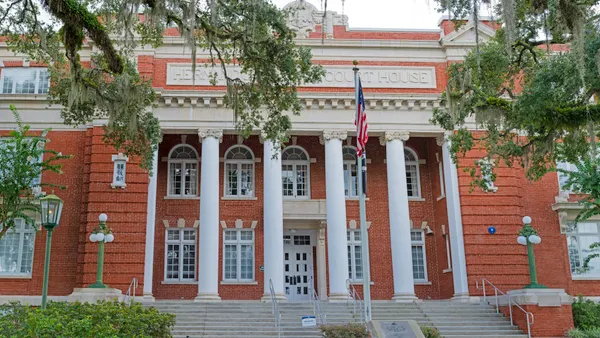Dive Brief:
- Snohomish County, WA, home to the United States' first case of COVID-19, has launched a new chatbot service to better communicate coronavirus information and resources to the public.
- The chatbot, which is a dedicated feature of the county's new Office of Economic Recovery and Resiliency, enables the business community to receive quick, automated answers to common questions regarding everything from reopening guidelines to financial assistance.
- Users can leverage the chatbot online or through any voice assist device, such as Amazon Alexa or Google Home. The bot was developed by Microsoft and voice tech company Zammo.
Dive Insight:
Snohomish County, which sits just north of Seattle's King County, is a predominately rural and suburban region that's home to about 880,000 residents. Over 20,000 county residents filed unemployment insurance claims as of March, according to the most recent data from the state's Employment Security Department, and the county itself is struggling to maintain operations with its current staffing bandwidth.
"Our own governmental structure is very slim," said Kent Patton, communications director for the Snohomish County Executive, in an interview with Smart Cities Dive. Patton said unemployment has been one of the biggest challenges for the county: many small businesses have ceased to function, and Boeing, which has its largest manufacturing center in Snohomish County, shut down for a few weeks leading to a "cascading effect across the community."
In response, the county set up its Office of Economic Recovery and Resiliency to better communicate information as it moves into COVID-19 recovery. However all of the county's economic and workforce development efforts, including running this office, fall on only three people: Kendee Yamaguchi, executive director of economic development; James Henderson, chief of economic and workforce development; and Simreet Dhaliwal, administrative assistant of economic and workforce development.
The chatbot was derived as "a force multiplier," said Patton. "This allows us to essentially stretch our staffing, and it's a much better interface for the public."
That interface for the public — particularly the service enabled by voice technology — provides an entirely new frontier for the county to communicate information to residents, Zammo CEO and Co-Founder Alex Farr told Smart Cities Dive in an interview.
"Everybody wants to just ask a machine, and have the machine answer accurately and instantly," Farr said. "Every business, every entity, if you have a website ... you need a voice presence. Period, end of story. It's a utility, it's not a choice anymore."
Farr explained that voice enables users, like Snohomish County businesses, to "cut the crap and go right to the heart of what you want." Additionally it's a "no-touch" option for information sharing, which is a particular benefit amid current health concerns.
Voice technology is still in its earlier stages of adoption, particularly for uses like commerce. The number of "smart speaker shoppers" is expected to grow about 18% this year, Mobile Marketer reports, which is a drop from previous projections — yet the use of voice technology is not exclusive to commerce and could potentially be better suited for other uses.
While the tech is not yet widely used among governments, Farr said Zammo is "betting that voice is going to be a thing and everybody is going to want it," especially as automation becomes more ubiquitous across most industries.
And regardless of its popularity in other use cases, Patton said voice technology and automated chat services will be a helpful function "even in day-to-day operations of the government," beyond the pandemic.
“As staff are furloughed or positions not filled, there will be fewer people to do increasingly more work. We anticipate tougher economic times — more need for social services and correspondingly more need for our law and justice services — but we’ll have fewer people," Patton said. "These kinds of technologies are exactly what help us maintain good public service with our residents."
To keep up with all of our coverage on how the new coronavirus is impacting U.S. cities, visit our daily tracker.











